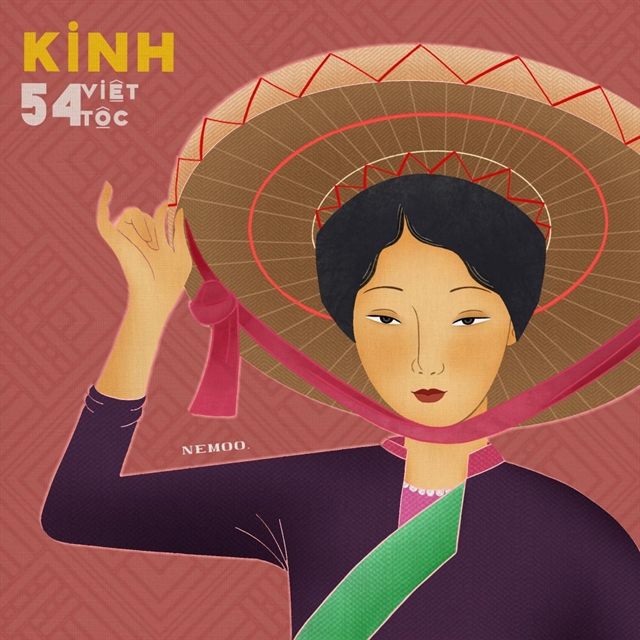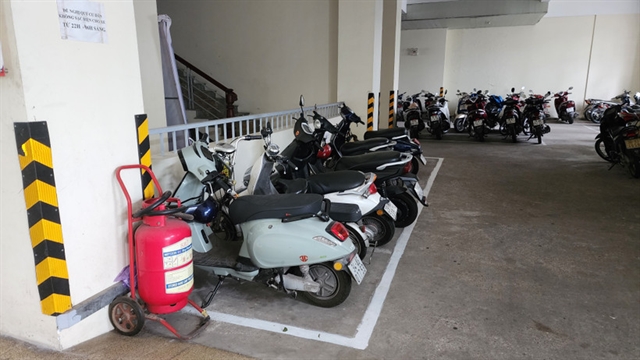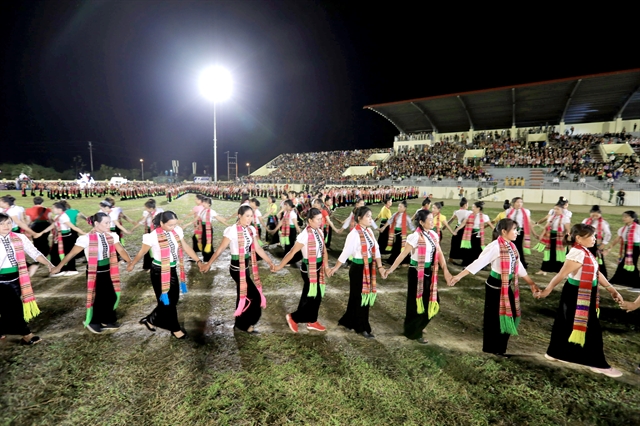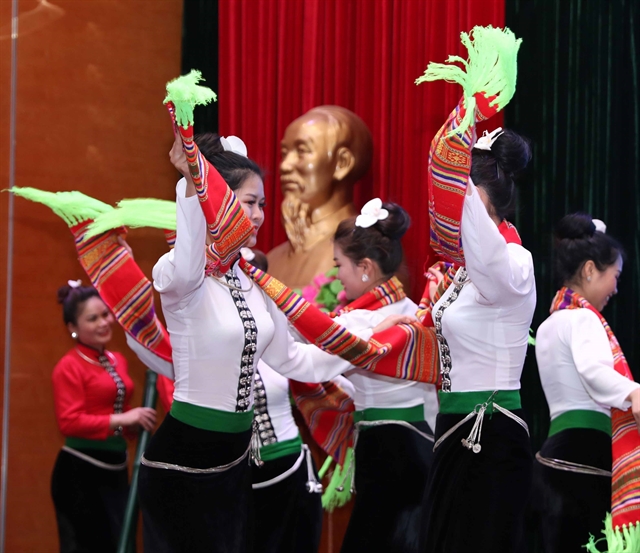 Features
Features

As a form to connect people’s aspirations with the divine world, xòe dance has long been an indispensable part of the Thái ethnicity's spiritual life in the four northern mountainous provinces of Yên Bái, Lai Châu, Sơn La and Điện Biên.

|
| DANCING QUEENS: Ethnic Thai women in traditional costumes performing a xòe dance at a festival held in Mường Lò, Yên Bái Province. Photo nhandan.vn |
It is common for the ethnic Thái people to exclaim, "No xòe, no love! No xòe, no fun!" when they speak of xòe dance, a unique cultural activity of the northwestern mountain regions.
As a form to connect people’s aspirations with the divine world, xòe dance has long been an indispensable part of the Thái ethnicity's spiritual life in the four northern mountainous provinces of Yên Bái, Lai Châu, Sơn La and Điện Biên. It was recently recognised as an Intangible Cultural Heritage of Humanity by UNESCO.
The dance reflects the Thái people's view and outlook of the world, including heaven, earth, and the gods. It also shows their wishes for happiness, health, and prosperity.
The Thái people believe that "if there are no xòe dances, maize cannot grow and rice is not good". The dance is a symbol of love, from the love of labour to the love of couples.
About 30km from Lai Châu City, Mường So Commune in Phong Thổ District is considered the cradle of the white Thái xòe dance that captivates visitors with its charming performances by local dancers.
The word xòe means to dance with movements that represent human ritual, cultural and working life. Thái people often perform xòe during spring festival ceremonies or to celebrate good harvests and weddings.
The dance is accompanied by harmonious melodies and the sounds of drums, gongs, and pan pipes during festivals.
Tao Thị Phè, a celebrated dancer of the xòe dance team in Hổi Én Village, Mường So Commune, said that in the past her commune and other areas such as Bản Lang and Khổng Lào of Phong Thổ District were well known for many xòe dance groups.
Phè, who used to perform xòe dance to welcome guests of the then Thái King Đèo Văn Ân, revealed that in 1946 when the King ascended to reign the areas, an amateur team of xòe dancers was established with about 20 members aged between 12 and 15. The dancers were summoned to perform whenever the King had guests or on New Year's holidays.
"At first, the dance was very simple without any set process. It was often mixed with props such as fans, scarves and hats. Gradually, it became more and more sophisticated due to the improved skills of the dancers," Phè said.

|
| ALL FOR XÒE: As a form to connect people’s aspirations with the divine, xòe dance is an indispensable part of the cultural activities and spiritual life of the Thai ethnic group. — Photo nhandan.vn |
According to many village elders, the art form was created from the working life, customs and beliefs of the Thái people. It now includes a total of 36 ancient dances typical of the Thái folk art.
Whenever spring comes, women buy new dresses to join the dance. The basic dance movements show the hands raising, opening, lowering, and holding other people's hands alongside rhythmic foot stepping.
As the dance makes people feel refreshed and more supple, it is usually performed at weddings, festivals and other cultural events.
The Thái people perform xòe also to highlight their cultural identity and values.
The dance is also a symbol of equality because once a person joins the dance, they no longer feel any distinguishing between rich and poor, or old and young, according to cultural experts.
Mào Thị Ổn, head of the Elderly Association in Vàng Pheo Village, Lai Châu Province, has been researching the origins of xòe dance. She said it was hard to know exactly when the folk dance was first created.
It has certainly been passed down among many generations. Some say it is 1,000 years old.
"The country dance is held in many festive activities of the community. After hard days working in the fields, the locals, mostly women in the village, gather hand-in-hand to dance. No matter how old or young, when entering the dance circle, everyone feels human emotions and are more attached and happier," Ổn said.
Vương Thế Mẫn, chairman of Phong Thổ District's People's Committee, said the land of Mường So and Khổng Lào was identified as the cradle of Thái ethnic culture in Lai Châu Province.
"In the folklore of the Thái ethnicity, the dance is the soul of their culture so they have been focusing on preserving it by promoting more xòe dances in traditional and festival events. The dance has become more and more popular attracting the participation of a large number of villagers," Mẫn said.
Currently, all villages in Mường So Commune have their own xòe dance teams of different age groups.
These teams have contributed greatly to restoring and promoting the cultural values of the Thái people, according to the district official.
Determining xòe dance as the core of Thái ethnic culture, Phong Thổ District has developed a project to promote the art genre to attract tourists to the area.
Promotion and preservation
The UN cultural agency UNESCO on December 15 last year announced xòe dance of the Thái ethnic minority in Việt Nam as an Intangible Cultural Heritage of Humanity.
"Xòe has been known as “xòe khăm khen” (hand-held dance), which arose during the people’s work, daily life, customs and festivals," folklorist Lò Văn Biến in Nghĩa Lộ Town, Yên Bái Province, who has devoted himself to the study of Thái culture, told the Quân Đội Nhân Dân (People's Army) newspaper.
Many xòe dance movements simulate Thái ancient people’s steps in clearing the land and fields, planting rice, collecting water, throwing handkerchiefs and offering wine. All vividly show the reality of life and express the aspirations and dreams of the people in the north-west, he said.
According to Trần Hữu Sơn, an expert on xòe dance and director of the Institute of Applied Folklore, it is necessary to conduct research for the unified conservation of the Thái folk dance, but it must be respectful of the communities.
The typical characteristic of xòe is the body movements including shrugging and walking that demand the dancers to move both feet and arms along with music, the expert said.
"The Thái soul is most evident in the xòe vòng (circle dance). In any entertainment activity, Thái people hold hands while dancing and do not distinguish among regions or areas. The unique culture in each region contributes to enriching heritage."
The UNESCO recognition has helped increase awareness of the importance of heritage in connecting Thái individual communities and ethnic groups, said Hoàng Đạo Cương, deputy minister of Culture, Sports and Tourism.
"To protect this heritage, training courses should be organised for the younger generations while events honouring master dancers should be held to raise awareness of the community about the value of the dance," he said.
Since the 1990s, Thái communities in the four provinces have taken measures to preserve their folk dance, including establishing xòe dance troupes, encouraging celebrated dancers and local researchers to make records and publish documents on the history and development of the dance.
Master dances and those who have knowledge and understanding of the art genre have been invited to teach xòe dances to younger generations, including preschool children and students at high schools and art schools.
About 180 Thái dance troupes have been established in Yên Bái, while the figure in Điện Biên is 1,273; Lai Châu has over 100 and Sơn La has about 1,700 teams.

|
| HAND-IN-HAND: Whenever spring comes, women buy new dresses to join the xòe dances. — VNA/VNS Thanh Tùng |
The Ministry of Culture, Sports and Tourism recognised xòe dance as the national intangible cultural heritage in 2013 and 2015.
At the same time, the People's Committees of the four provinces approved a number of projects to collect and popularise several xòe dances and provide financial support to various cultural groups.
Every year, the People's Committees of the four provinces also organise cultural weeks, cultural festivals of ethnic minority groups, performances and contests featuring xòe dance.
With both domestic and international attention, this folk dance is set to be passed down and preserved for future generations. VNS




